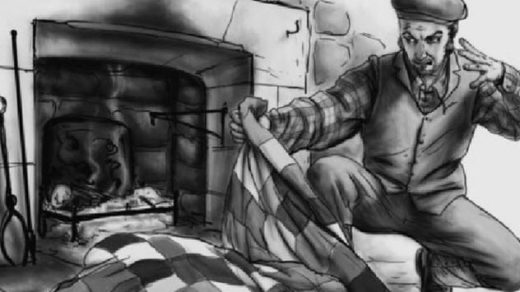Margaret Dickson was hanged on the 2 September 1724 at Edinburgh. Her crime was that of infanticide, namely that she had murdered her newborn baby. She worked as a domestic and it was her story that she had become pregnant by one of the sons of the household, a common enough occurrence. So that she would not lose her job she concealed the fact she was pregnant and gave birth in secret.
According to her, the child was born dead and so she had disposed of the body on the banks of the local river Tweed. The small body was discovered later that same day. Investigations led back to Margaret Dickson and when questioned she admitted the baby had been hers but maintained that it had already been dead and her only crime was in the way in which she tried to conceal the body.
She was tried at Edinburgh and although the evidence was weak was found guilty and sentenced to death by hanging. As was usual in those days a large crowd gathered to witness the passing of Margaret Dickson and were not disappointed. She was hanged and her body left suspended for the customary 30 minutes. Her body was cut down and taken away in a coffin on a cart to be buried several miles away. At one stage the driver of the cart had stopped for a break and thought he heard noises coming from the coffin. He was right, for some unknown reason Margaret was not dead and had revived and was now trying to get out of the coffin.
This was perhaps seen as divine intervention and she was given a full pardon, she went on to live another 25 years.
The Hanging of Margaret Dickson
The true tale of a woman who survived a public hanging
By Alison J. Butler
In an age when women are expected to know their place, be submissive, dutiful and chaste, Maggie Dickson, a Musselburgh fishwife, is often in trouble. She’s outspoken, promiscuous and vituperative. While her husband’s at sea she sells her fish sleeps with men for pleasure or money and looks after her two bairns’. In time, her husband abandons her. Maggie quits Musselburgh and heads for Newcastle to stay with relatives.
During the winter of 1723, a fisherman finds the dead body of a naked, baby boy. Fingers are soon pointing in the direction of a stranger working in a local tavern, a woman recently estranged from her mariner husband. It is rumoured that she’s been having a passionate affair with the innkeeper’s young son, William Bell and that he is the father of the dead child.
Maggie is arrested and taken to Edinburgh tollbooth to await trial, she is found guilty and sentenced to death. The news spreads like wildfire, and as Maggie languishes in jail the whole city speculates whether or not she killed her child. Will she take her secret to her grave? The Hanging of Maggie Dickson is a heartrending tale of sexual obsession and unrequited love. Synopsis Maggie Dickson is a free spirit, with a love of life and a love of men, in particular, young, handsome men. There are two obstacles. The year is 1723, and Maggie is a married mother of two children.
The Hanging of Margaret Dickson is based on the true story of a hanging went wrong in Edinburgh, Scotland on September 2nd 1724. It highlights the plight of peasant fisherwomen and their admirable ability to survive. Tough, resourceful, indisputably feminine, Maggie’s voice speaks to us across the centuries with shocking familiarity. Coastal Scotland and the bleak life of fishery folks are the cultural settings for this incredible tale. Maggie Dickson, a flawed character of great drama, courage and lustful heart, is born to an alcoholic, philandering father and a disillusioned mother. On her wedding day, she swears that she will be mastered by no man, not even her husband.
Her fisherman husband goes to sea and leaves her alone with two children to a starving subsistence. Maggie has no option but to use her considerable charms and looks to survive. One day when she is selling her fish at the market, she discovers a new and licentious source of secret income in nearby Edinburgh and embarks on a career of vice and debauchery. When her husband is press-ganged into the navy she abandons her children to a friend and begins her calamitous journey. She heads from Musselburgh to relatives in Newcastle to find her husband.
With an adventurous spirit, she discovers a new feeling of freedom and seeks her decadent destiny. After almost freezing to death along the way she ends up in a tavern in Kelso. The landlady likes her and asks Maggie to work there for board and lodgings. The life of a tavern wench suits her well and Maggie thrives for months until she develops a sexual obsession for innkeeper’s son, William Bell. She is swept away into a deep and all-consuming love by the tall and attractive young man, yearns for him and finally begs for his attention. In the heat of the moment, there is one passionate interlude that tears her world apart. The young man walks away knowing she is married and off-limits. Her forbidden love festers to the point where Maggie completely loses her mind.
She finds herself pregnant with William’s child and contrives to conceal her condition. Risking her own life she delivers the secret child prematurely. After a few days, hidden under her bed, the baby dies. Heartbroken, Maggie determines to throw the baby in the River Tweed, to avoid implicating William, but loses her nerve and places it at the water’s edge. A local fisherman discovers the body and notifies the magistrate.
Maggie is arrested and taken to Edinburgh for trial, found guilty and sentenced to death. She dwindles away in the most horrible prison conditions, common to the time, chained to a rail with the dead and dying. After her dramatic trial, Maggie is hanged by the executioner, John Dalgliesh, and death is pronounced by the attending doctor. Her body is cut down and placed in a coffin.
The funeral party in charge of the corpse stop at a tavern for refreshments, leaving the coffin and cart outside. Meanwhile, two passing joiners hear noises coming from inside the coffin and inform the father and friends. When the lid is taken off the corpse rises, alive! Spectators run for their lives but her father, Duncan, holds her in his arms. She is taken to Musselburgh and recovers full health where she is reunited with her husband. He forgives her and marries her for the second time. They have a son, James Spence, ten months after her trial. True to form, the infamous and shameless Margaret Dickson remains unrepentant and runs an alehouse in Berwick, Scotland where she lives until as late as 1753.
1724: Half-Hangit Maggie Dickson
Allegedly on this date in 1724, a young woman was hanged at Edinburgh’s Grassmarket for concealing her pregnancy.
Any number of details in this horrible/wonderful story is shaky, including the date: some sources make it 1728, a few say 1723, and only a handful attest a specific calendar date. Nobody seems to doubt the tale in the main, however — and it’s certainly excellent enough lore to deserve even a heavily asterisked entry.
Deserted by her husband, young Maggie Dickson took lodgings at an inn in exchange for work and became pregnant by either the innkeeper or his son. (Again — details in the various sources available read like a game of telephone.) Since single pregnant working-class women had about as many employment options like birth control options, Maggie kept quiet about her condition in the interest of keeping her job.
And since male parliamentarians figured their job was to keep young lasses of loose character and modest means on the straight and narrow by criminalizing their options, Maggie’s sleight-of-womb put her in violation of a law against concealing a pregnancy. (The same situation was playing out elsewhere in the British sphere at this time.)
When the resulting infant turned up dead, the trail led straight to Dickson … but the concealment of the pregnancy and birth were capital crimes on their own, making it immaterial whether it had been a miscarried pregnancy, an act of infanticide, or simply one of the many early 18th century babies to die in the cradle. The law was an indiscriminate instrument to prevent women from terminating their pregnancies.
Nothing noteworthy about the hanging itself is recorded; it seems to have been one of the routine public stranglings of the age, and even the scuffle over the body between family and medical students hunting dissection-ready cadavers was a normal occurrence.
The family won. And en route to Musselburgh for burial, Maggie started banging on the inside of the coffin and was forthwith revived. Officials decided the sentence of hanging had already been carried out … and her awestruck neighbours suddenly started seeing Maggie sympathetically
And they all lived happily ever after. This day’s principal, at any rate, gained a foothold in adequate prosperity, bore more children, and answered to the nickname “Half-Hangit Maggie Dickson” all the many more years of her life.
The story of Maggie Dickson
Maggie Dickson lived in the Early Eighteenth-century as a fish hawker and would certainly have remained an anonymous figure had she not been the subject of a public hanging.
Her misfortune began when her husband deserted her in 1723 forcing her to leave the city and move further south to Kelso near the Scottish Borders. Here, she worked for an innkeeper in return for basic lodgings.
Soon after she started an affair with the Innkeeper’s son which led to her becoming pregnant, not wanting the innkeeper to discover this as it would surely lead to her instant dismissal she concealed her pregnancy as long as possible. However, the baby was born prematurely and died within a few days of being born. Still hiding the baby’s existence she planned to put the baby into the River Tweed, but couldn’t bring herself to and finally left it on the riverbank.
The same day the baby was discovered and traced to Maggie. She was charged under the contravention of the Concealment of Pregnancy Act and she was taken back to Edinburgh for trial and execution – the latter taking place in public in the Grassmarket on the 2nd September 1724.
After the hanging, she was pronounced dead and her body was bound for Musselburgh where she was to be buried, however, the journey was interrupted by a knocking and banging from within the wooden coffin.
The lid was lifted to the sight of Maggie, quite alive. The law saw it as God’s will and she was freed to live for a further forty years. She became something of a local celebrity and the locals gave her the nickname ‘Half Hangit’ Maggie.’
Some said that she had seduced and manipulated the ropemaker, to engineer a weaker noose.
A pub in the Grassmarket is named Maggie Dickson’s after her memory, which means her name and story will be remembered for some time yet.




I do trust all the ideas youve presented in your post They are really convincing and will definitely work Nonetheless the posts are too short for newbies May just you please lengthen them a bit from next time Thank you for the post